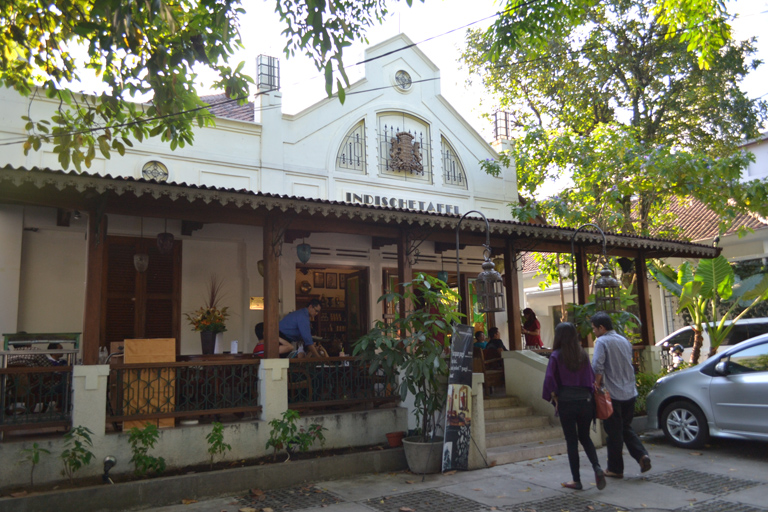Although sandwiched between a video store and a factory outlet, Resto Indischetafel is a zealous stab at reviving Bandung tempo doeloe of the Dutch reign.
Shaded by a leafy overhang, the restaurant’s concrete porch is flanked by birdcage lanterns. Sunlight suffuses the hallway’s floral-patterned flooring; the high stuccoed ceiling and lazy strains of keroncong (traditional Indonesian folk music), crackling in plausible imitation of a warped record, establish the restaurant’s aim to lull diners to yesteryear.
The main dining room, however, is the real tribute to colonial Europe. Scarlet drapes frame the tall, stained-glass windows while wooden cross chandeliers glimmer overhead. Despite the damask booth seating and embroidered tablecloths, there is none of the hoity-toity atmosphere typical of such furnishings. Even so, I would advise diners to don business or smart casual, else you may feel underdressed.
Charmed by the restaurant’s aesthetic, we were salivating in anticipation of great food. The hefty menoe initially intimidates with its all-Dutch headings and enormous selections of appetizers, desserts and foamy beverages. Closer inspection reveals, however, that a disappointing number of the main courses are Indonesian dishes spelled in the colonial Dutch “oe” for“u”, “tj” for “ch” and “j” for “y” (Nasie Tjampoer, anyone?). To be fair, the restaurant touts itself as an Indo-European eatery; and the poffertjes-heavy dessert menu and – comparatively modest - Oost Indische Gerechten (Indo-European dishes) section somewhat justifies the tag line.
The Chicken Steak a la Indische we shared, looked and tasted more like chicken katsu and needed tackling with no less than a steak knife. Having eagerly earmarked the Coconut Klaapertart for desert, I was disappointed to hear it was unavailable. The banana poffertjes I opted for instead more than placated me, however. The dough ball-shaped pancakes were drizzled in warm caramel and powdered sugar. The batter was soft and creamy, a texture achieved by being right on the cusp of undercooked –though we had to mop every last drop of the rather sparse caramel sauce.
My verdict? The drinks are great: I would recommend the Paris van Java on a hot day. The blend of strawberry, pineapple yoghurt and soda promised in the menu is so well-balanced that you can distinguish each ingredient.
The Amsterdam is really just a mean Oreo milkshake with a surprise scoop of vanilla ice cream lurking underneath the cookie, but easily outperforms the oft watered-down milkshakes we’ve come to expect in Jakartan restaurants.
By all means, visit for the poffertjes and foamy drinks – they really are as delicious as the menu describes – and the undeniably soothing visual immersion in “the olden days” but don’t expect the main courses to outdo the fare at your average family eatery. As we left, my companion remarked, “Did we just eat in a museum or a restaurant?” I shrugged, and we laughed.

